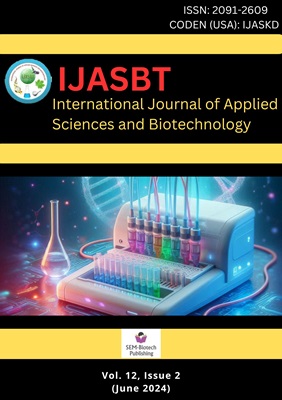Evaluation of Five DNA Extraction Methods for Dillenia pentagyna Roxb. and Hardwickia binata Roxb. Suitable for PCR Amplification
DOI:
https://doi.org/10.3126/ijasbt.v12i2.64794Keywords:
Endangered, PCR, SSR, CTABAbstract
High-quality genomic DNA extraction is crucial for the conservation of forest genetic resources, particularly for endangered species like Dillenia pentagyna Roxb. (Karmal) and Hardwickia binata Roxb. (Anjan), which hold significant value in traditional medicine and economics. The presence of contaminants such as polysaccharides, polyphenols, and secondary metabolites in forest trees complicates the isolation of sufficient, uncontaminated DNA. In this study, we evaluated five DNA extraction protocols, including those by Doyle and Doyle (1990), Michiels et al., (2003), Porebski et al., (1997), Khanuja et al., (1999), and Deshmukh et al., (2007). Quantification and quality analysis of the extracted DNA were conducted using a Nanodrop spectrophotometer and Agarose Gel Electrophoresis. Notably, minor modifications to the CTAB-based method outlined by Doyle and Doyle (1990) significantly enhanced DNA quality. The absorbance ratio at 260/280nm indicated mean purity ratios of 1.62 for D. pentagyna and 1.7 for H. binata, with DNA concentrations recorded at 341.6 μg/ml and 317.72 μg/ml, respectively. The Doyle and Doyle (1990) method consistently produced high-quality DNA, devoid of contaminants. Subsequent PCR amplification with SSR primers confirmed the suitability of the extracted DNA, exhibiting distinct and well-defined bands.
Int. J. Appl. Sci. Biotechnol. Vol 12(2): 54-61.
Downloads
Downloads
Published
How to Cite
Issue
Section
License
Copyright (c) 2024 International Journal of Applied Sciences and Biotechnology

This work is licensed under a Creative Commons Attribution-NonCommercial 4.0 International License.




